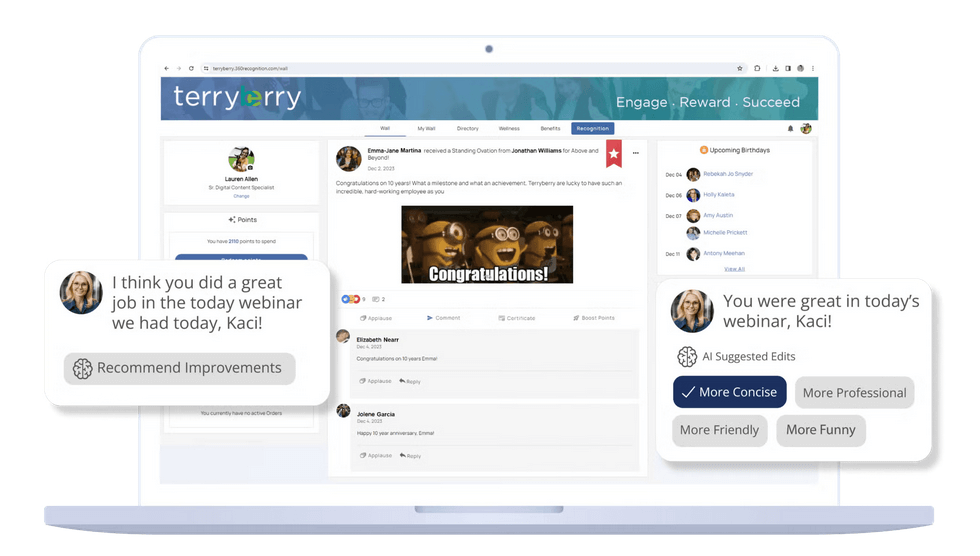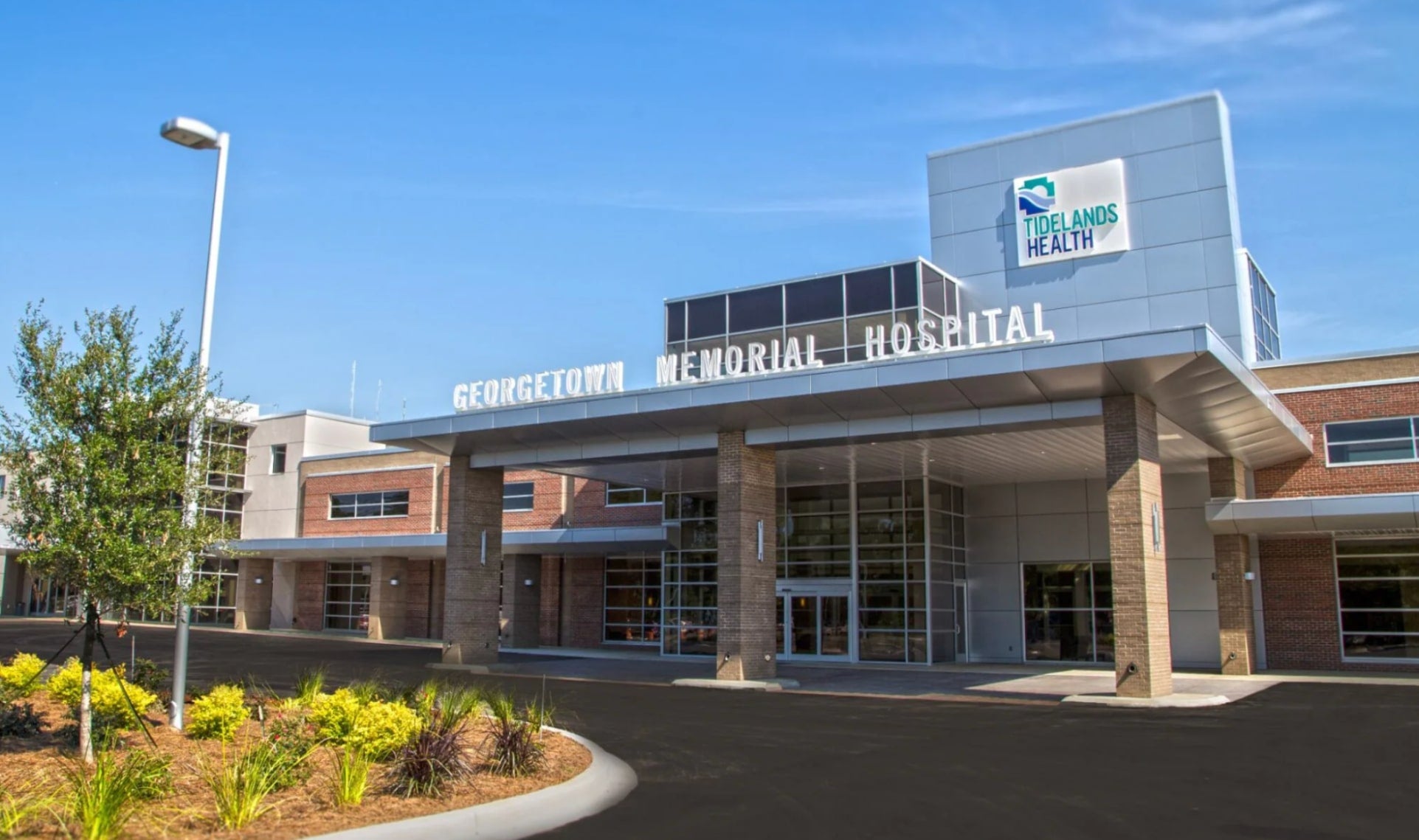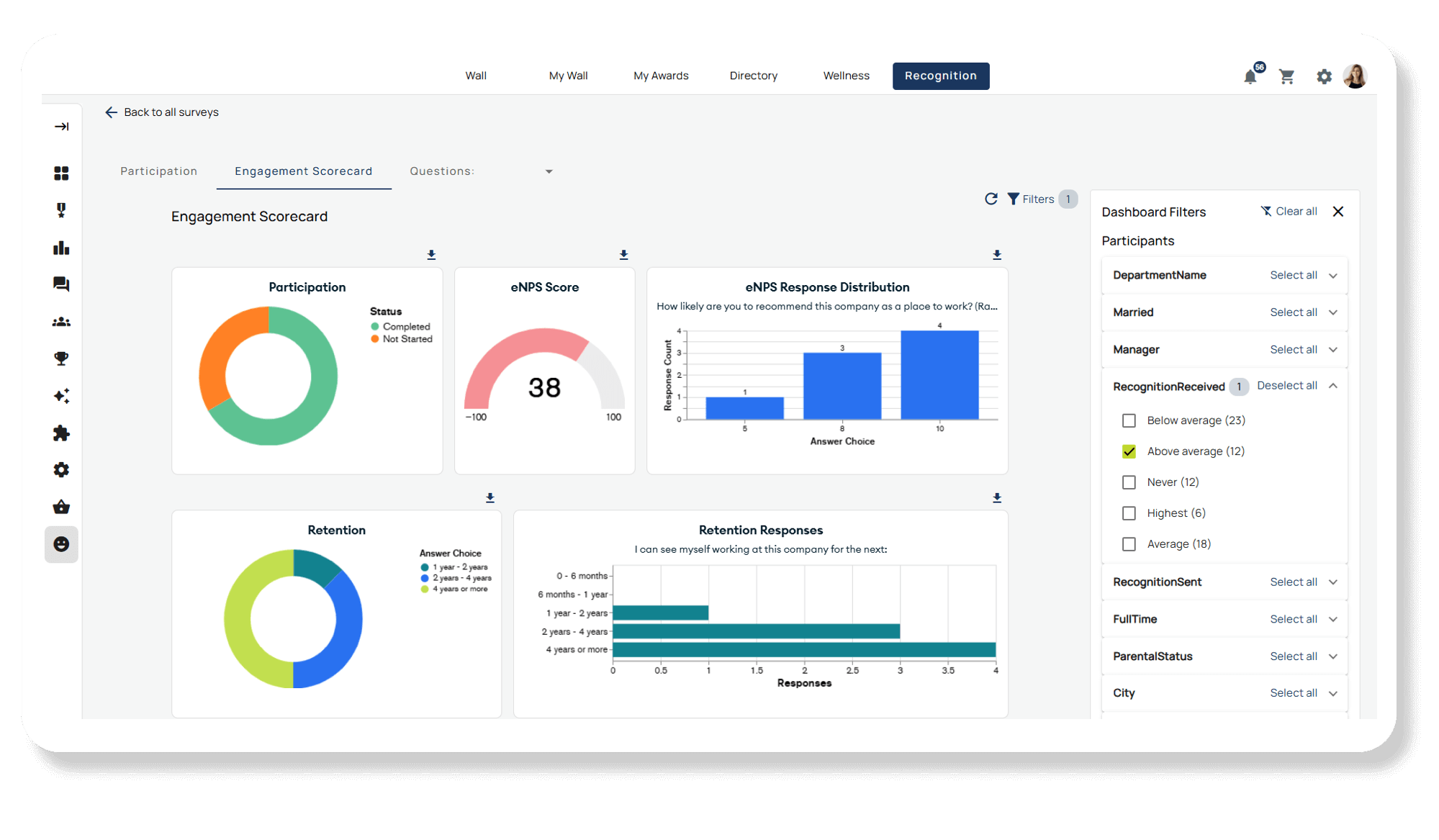May 23, 2025

Employee recognition can take many forms, from letters of recognition to awards for top performers. However, the biggest challenge for HR teams when designing recognition programs is making sure they’re aligned with business goals and employee preferences. And they also need to make sure initiatives don’t have unintended consequences, such as breeding toxic rivalry.
In this article, we’ll share message templates that managers and team leaders can use to recognize their employees in writing, list other types of employee recognition worth implementing, and provide examples of companies that have built successful employee recognition programs.
We'll cover how to:
- Create a Culture of Appreciation with 170+ Templates for Recognition Messages
- Make Sure Your Employee Recognition Program Has Real Impact
- Customize Your Program to Match Company Goals and Employee Needs (with Examples)
- Track the Impact of Recognition Initiatives and Continue Optimizing Them
- Terryberry: The Only Platform That Can Measure Employee Recognition ROI
Create a Culture of Appreciation with 170+ Templates for Recognition Messages
One of the easiest ways to express appreciation is by sending your employees a written message recognizing their hard work and dedication to the company. The most common forms of this are letters celebrating employee anniversaries or their contributions to large projects. But they can also be sent out to recognize smaller actions, like acting in alignment with company values or helping resolve a conflict.
Recognition messages that make employees feel appreciated share some common traits. Specifically, they:
- Provide context and specific details
- Highlight the impact of an employee's action
- Are connected to specific milestones or actions
Terryberry has built a library of employee recognition message templates that leaders and peers can use as a starting point. We’ve shared them with our blog readers in several articles and have included some of those templates, plus links to full message collections, below.
Write Letters of Recognition for Formal Employee Appreciation
If you’re looking for a way to acknowledge a significant work milestone or show appreciation for an outstanding contribution, letters of recognition are one of the ways to do so, especially in companies with a strong work culture.
We'll share 9 recognition letter templates plus 6 tips on writing them—including words and phrases to highlight an employee’s contribution.
Here’s an example of a letter you could send to a team member who helped complete a large project:
Dear [employee name],
I wanted to thank you for your impressive work on the [client] project. Your dedication, hard work, and expertise played a critical role in the success of this major initiative.
From the start, your commitment to [specific aspects of the project] was evident. Your ability to [specific skill or quality] has significantly contributed to [positive outcome or impact of the project]. Specifically, [describe a key achievement or contribution], which has [explain the benefit or result].
Your work didn't just ensure we completed the project successfully, but set a new benchmark for excellence within our team. You've made a lasting impression, and we're fortunate to have you at [company same]. We look forward to seeing your continued success on future projects.
Once again, thank you for all of your outstanding work.
[your name]
[position]
[company name]
[contact information]
View more templates for different letters of recognition here.
Share Messages of Appreciation for Actions Aligned with Company Culture
While letters of recognition are a great way to show appreciation in a more formal way, they can also help find opportunities to praise employees for smaller accomplishments. This approach is especially relevant for companies that want to encourage their teams to act in alignment with company values.
One of our articles includes 87 recognition messages that can be used to praise team members for such actions as mentoring others, showing grit and determination, or working well with their team members. Here are some examples:
Recognizing Teamwork
- “Teamwork is the foundation of our success, and your role in it is irreplaceable. Thank you for your outstanding cooperation and support.”
- “Your ability to bring out the best in others and work together toward common goals is inspiring. Thank you for being an exceptional team member.”
- “The success of our team is built on the efforts of each individual, and your teamwork has been instrumental. Thank you for your dedication.”
Saying Thank You to Mentors
- "Your ability to mentor and inspire others is truly remarkable. Thank you for sharing your expertise and helping our team thrive."
- "Your dedication to mentoring, as well as your patience and empathy, has made a significant difference in the lives of your colleagues. Thank you for your generous spirit and wisdom."
- "Thank you for being an exceptional mentor. Your guidance and support have done a fantastic job in helping shape the future of our team"
You can find more employee appreciation message templates in this article.
Provide Positive Feedback to Recognize Employees’ Successes
As well as sending out messages to celebrate actions aligned with company values, it can be useful to include positive feedback in reviews or as a part of communications with line managers or team leads. This is especially relevant for teams where employees want to feel recognized and appreciated by their immediate supervisors, e.g., frontline employees in service industries.
To provide this kind of feedback, you can use one of these 78 message templates to celebrate your team members for creating an exceptional customer experience, successfully resolving conflict situations, and more:
Providing an Exceptional Customer Experience
“I just heard about the great feedback from [client] and while I’m impressed, I’m not at all surprised. This is a perfect example of how you always manage to make our clients feel like they’re the only person we serve. Thanks for representing [Company] so well!”
Navigating a Conflict Well
“If you didn’t work here I think you would thrive as a diplomat for our country. You never lose your cool under pressure and always manage to help people find resolution when there’s conflict. Thanks for being such a problem-solver!”
Embodying Company Values
“I don't know many people who consistently demonstrate their commitment to [value] as well as you do. Thanks for being a team member we can all trust to point us in the right direction.”
View the full collection of positive feedback templates here.
In addition to a template library for leader-led and peer-led recognition messages, Terryberry now offers AI tools to help write meaningful recognition messages inside the platform.

Make Sure Your Employee Recognition Program Has Real Impact
Top-down recognition is a great way to encourage actions that are aligned with company culture and motivate better performance. But in our experience of working with over 40,000 global clients, the most successful employee recognition programs combine different types of employee recognition.
The reason why we see such programs work better is that employees have different needs, motivations, and career aspirations, and different teams have different KPIs and goals they need to accomplish. While some team members appreciate letters of recognition or messages from their direct supervisors, others are more motivated by incentives to improve their performance.
At the same time, those programs need to avoid incentivizing “wrong” behaviors that might lead to a Hunger Games mentality on a sales team, with managers displaying favoritism by consistently praising only a handful of employees, or ending up with a rigged peer-to-peer program where cliques reap all the rewards.
Effective employee recognition programs need to both match the ways employees want to be recognized and contribute to company goals in a measurable way.
Here are the key forms of recognition that go beyond messages of appreciation:
Celebrate Employee Accomplishments
These celebrations can include:
- Service awards, such as:
- Celebrating the anniversary of a team member joining the company
- Milestone awards, such as:
- Birthdays
- Completing training programs
- Reaching a sales target
This type of recognition can help reduce turnover and motivate employees to align their actions with business goals (e.g., meeting sales targets or acquiring certifications necessary for compliance).
Peer-to-Peer Recognition
Frequently used as a way to celebrate employees who act in alignment with company values, recognition from peers can be a friendly message, or it can be tied into a rewards program to have employees gather points and then turn them into gifts or experiences. This type of recognition is especially useful for companies with multiple locations and for remote teams, because it helps build company culture and reinforce specific desired behaviors, such as with customer support teams or teams that need to work well together.
Incentives and Awards
Incentives and awards can (and, actually, should be) tied to company goals and specific outcomes. They can be used to incentivize better performance (for example, “Best Salesperson” or “Top Performer”) or to motivate teams to perform better as a unit.
This form of recognition can be anything from yearly black-tie award events to managers sending a gift to their top performers or buying lunch for a team that accomplished a specific project milestone.
Many of our clients combine milestone rewards, peer-to-peer recognition, manager recognition, and incentives in different ways across teams to:
- Motivate sales teams to close more deals
- Encourage customer-facing teams to keep a high standard of service
- Build a stronger internal culture for deskless or remote employees
- Improve employee well-being and prevent burnout
- Increase job satisfaction and retain top-performing employees through recognition programs, while motivating other team members to improve their performance.
Below, we’ll explain how you can identify which forms of recognition are likely to move the needle for your company and show some examples of employee recognition programs aligned with business goals from our clients.
Read our guide to building an effective employee recognition program:
- Best practices for employee recognition programs
- Benefits of successful programs
- Common pitfalls of poor execution
Customize Your Program to Match Company Goals and Employee Needs (with Examples)
For many HR teams, deciding which employee recognition program elements to combine to see desired results is challenging. But it’s not impossible, especially if you have the right tools.
Our platform, Terryberry, allows teams to combine different types of recognition programs, track their impact beyond usage metrics (for example, the number of employees logging in), and show the C-Suite how exactly program participation improves motivation, productivity, and employee retention.
Below, we’ll share examples from our clients showing how they designed successful employee recognition programs that felt meaningful to employees and helped their companies accomplish business goals:
- Building morale across diverse teams while reducing administrative workload.
- Increased work engagement for medical personnel with a flexible recognition program that allows for on-the-spot appreciation.
- Improved retention and stronger company culture during a period of rapid growth.
Example: Build Morale by Personalizing Recognition
Making sure that recognition messages and awards don’t come across as generic, cookie-cutter corporate initiatives is a real challenge, especially for large businesses. And the need to balance personalization with an ever-growing admin workload can pile extra burden on HR.
That said, combining efficiency with a personal touch is possible if you set up automated notifications for direct managers or team leaders. This way, employees feel that the messages of appreciation are genuine and reflect their true strengths.
In many cases, combining this kind of direct feedback with gifts or other types of recognition can work particularly well. For example, The Co-op—a group of businesses including grocery stores, funeral care, insurance, and legal services organizations—optimized their employee anniversary recognition program to improve employee retention and reduce admin workload.
As Terryberry worked with the Co-op’s HR team, we discovered that employees wanted their line managers to recognize their contributions in a unique and personalized way.
Now, line managers are notified in advance about upcoming employee milestones and can choose how to celebrate their team members: through a public award presentation, during a smaller meeting, or just 1:1.
For employees who enjoy being in the spotlight, managers can also share their story during the award ceremony and give them a shout-out through social media channels.
With the number of employees celebrating their milestones growing from 1,000 to nearly 10,000 per year, the Co-op saw a morale boost across teams and more buzz around the program on social media.
As program lead, Jane Walpu, mentioned in our case study:
"We were really impressed with Terryberry’s collaborative and creative approach in coming up with a solution that works so effectively for us. The team really took the time to understand our business and what’s important to us and came up with a creative solution that’s already having a really positive impact on all our colleagues.”
Not sure which type of recognition fits your organization? Schedule a demo to see how Terryberry can help you launch an impactful employee recognition program.
Example: Improve Engagement Through On-the-Spot Praise
Adapting your employee recognition program to employee needs can also mean adding almost-instant moments of recognition for small actions, instead of waiting to celebrate accomplishments during reviews or as a part of 1:1 conversations with team leads. Especially for frontline employees, getting in-the-moment praise for their actions creates a positive feedback loop and leads to higher performance and engagement.

For example, Tidelands Health switched from one-off gifts to ongoing recognition. They combined service awards with manager-driven and peer recognition across four hospitals and 60+ outpatient locations.
Having access to the Terryberry app made it easier to send messages of appreciation and award points, creating a positive feedback loop. At the same time, employees can use their points to choose meaningful gifts, increasing their satisfaction with the program and improving their engagement at work.
On average, less than 30% of managers in the medical industry participate in employee engagement programs, which have obvious consequences for morale.
At Tidelands Health, manager engagement sits at 44.35%—meaning nearly half of managers actively recognize and celebrate their employees’ contributions.
Example: Achieve Higher Retention and Improve Company Culture During Rapid Growth
When companies go through periods of rapid hiring, HR teams face the challenge of making sure they can successfully onboard and retain new employees. Particularly in industries with a high turnover, such as call centers, it can be a tough task. This is when it’s important to combine different types of incentives in a way that helps accomplish several goals.
For example, Freedom Financial Network needed to improve employee retention and reinforce company values as the company rapidly grew.
To do that, the HR team combined peer-to-peer recognition, point-based awards, and service awards into a branded program.
The peer-to-peer part of the program helps team members recognize when colleagues act in alignment with Freedom Financial’s core values. To reinforce those values, recognition messages are displayed in real time on monitors in office lobbies. Point-based awards add extra incentive for employees to stay mindful of the values, while service awards recognizing employment milestones help motivate long-term retention.
The program has been running for more than 6 years now, with employee engagement consistently hitting 77%—even as the company has continued to grow.
In the next section of this guide, we’ll talk about the ways to evaluate employee recognition program impact and show how you can use Terryberry to get that data and use it for ongoing program optimization.
With Terryberry, you can select or combine different types of employee recognition awards:
- Presentation kits that include a gift and a certificate with a personalized message
- Custom awards, developed in-house by our experienced designers and jewelers
- Access to a reward platform with the largest selection of awards on the market (now integrated with Amazon Business for zero markup and easy shipping)
Track the Impact of Recognition Initiatives and Continue Optimizing Them
While maintaining the same employee recognition program for several years works for Freedom Financial Network, some companies may need to make regular changes.
For example, HR teams may see their employee recognition budget cut, changing how many points they can award in any given month. Or they may need to recalibrate their program due to changes in the overall company strategy, such as hiring freezes or moving to remote work.
Sometimes, large disruptions mean focusing on strengthening your company culture after a merger or an acquisition, or building up employee morale after a round of layoffs.
To make changes successfully, you need to understand how to influence employees through a recognition program that aligns their behavior with company goals.
The starting point, of course, is understanding how your recognition program is performing right now. One of the most straightforward ways to measure the current impact of recognition initiatives is by tracking usage metrics over time. When combined with industry benchmark data, it’s a solid baseline to see if employees find it worthwhile to log in and participate.
Most Terryberry clients across industries have higher levels of engagement than the industry average. For Chelsea Groton Bank, for example, both manager and employee participation is more than 2x the industry average. Many employee recognition platforms track this data, making it easy for HR teams to include in their reporting.
However, participation in recognition programs isn’t directly tied to business outcomes.
It doesn’t show how these programs influence employees’ willingness to stay or recommend their workplace to others. Participation metrics also don’t reveal how much, if at all, different types of recognition drive productivity.
For example, if team members feel they’re underpaid, they’ll likely see reward points as a way to make up for the pay discrepancy, leading to lower appreciation for those awards and no changes in their overall performance.
This is why Terryberry’s platform also includes a survey module in all employee recognition programs.
You can use surveys to understand how employees feel about the company, the leaders, and the work environment, and design your employee recognition program based on that baseline data.
You can also run more frequent pulse surveys to answer more specific questions for cohorts, teams, or specific company locations, so that you can optimize current initiatives.
For example, you can combine engagement metrics and surveys to answer questions like:
- With recent changes in management, are there any specific locations where employees are dissatisfied with the leadership? If so, are those managers participating in leadership-led recognition programs?
- Do recent employees feel fully supported in their onboarding? Are there any teams where new hires need additional support? Can we improve their experience and motivation by adding milestone rewards for completing their onboarding training?
- On the team level, are there any differences in how top performers vs lagging performers perceive being supported in their work? Do team members feel disconnected, and is it something we can address through our peer-to-peer recognition program?
You can also use employee engagement reporting and dashboards to analyze trends and changes in engagement. Then, quantify the impact of your current programs by comparing data like employee NPS, retention, and overall engagement for employees who are receiving and aren’t receiving recognition.
With access to this data, you can answer questions like:
- Does kicking off a peer-to-peer recognition program have a significant impact on job satisfaction for frontline or deskless employees?
- Do leadership and peer recognition programs improve remote workers’ performance and sense of belonging?
- Does introducing an achievement award for sales teams encourage better results without affecting the team morale?
Being able to track this information can help fine-tune your employee recognition program to match team preference and company goals, as well as improve other aspects of employee experience, such as onboarding and meeting culture (this is exactly what happened at Numa Logistics).
And, of course, being able to access this information means you can prepare reports that show exactly how employee recognition initiatives contribute to the company's bottom line.
Further reading: Employee Satisfaction Survey: Templates, Questions & Tools
Find out how you can use surveys and reporting to uncover new opportunities for higher employee engagement and retention.

Terryberry: The Platform That Connects Employee Recognition and ROI
Terryberry combines all key types of employee rewards and recognition programs with surveys, granular reporting, and analytics. It simplifies work for HR teams and managers by automating notifications and reminders and using AI to monitor peer-to-peer recognition messages. But that’s not all.
We work closely with HR teams to help them build custom programs aligned with company culture and accomplish business goals related to sales performance, employee productivity, and/or staff retention. We also help organizations develop reports that measure the real-world impact of employee engagement programs, allowing you to build convincing business cases for expanding or optimizing your initiatives.
Book your demo today to see how Terryberry can help your organization launch or improve employee recognition initiatives.
